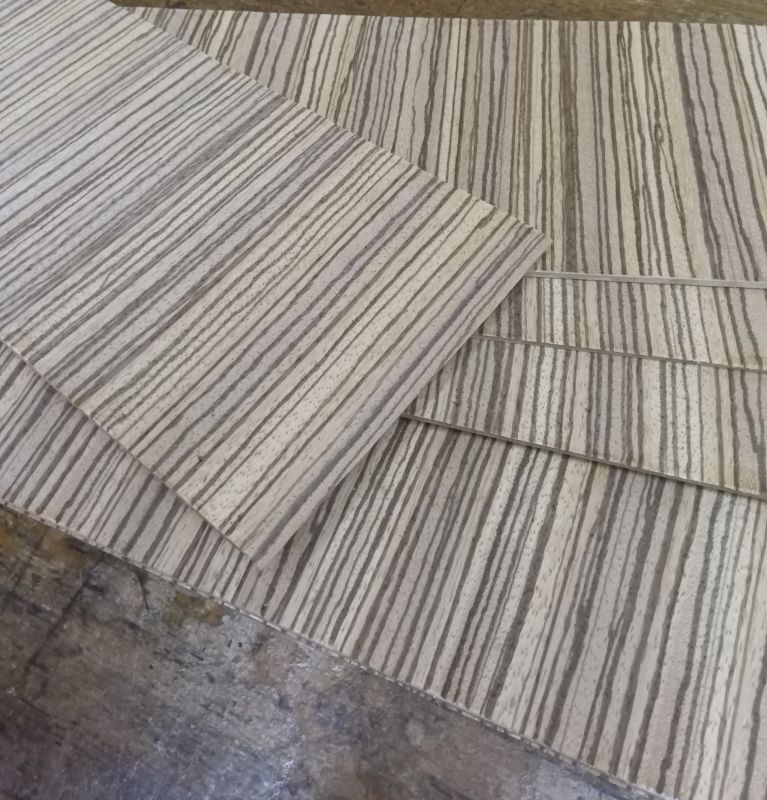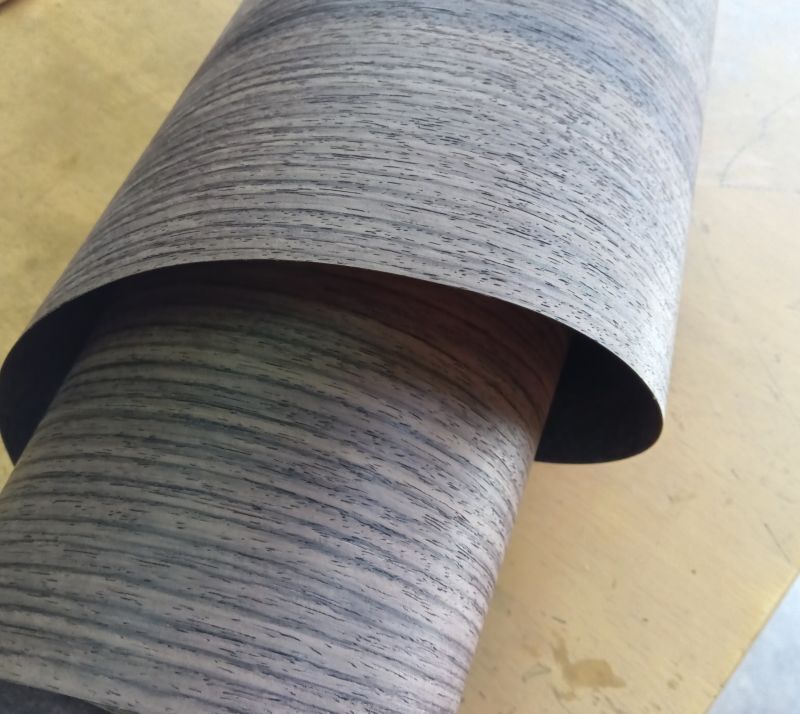Wooden sheet
I am currently making the 14 steps 4sun Japanese puzzle box, and this time, many of them feature a Zebrawood design. This zebrawood is, of course, real zebrawood, but it is not made from solid wood board. The wood used for the top and bottom surfaces of the puzzle box is approximately 3 mm thick. If solid zebrawood board were used, they would warp or shrink due to environmental changes such as humidity and temperature.
Therefore, I use zebrawood that has been thinly sliced and glued onto plywood. While plywood with pre-glued zebrawood is available, I prefer to use my own preferred plywood and glue the zebrawood veneer myself. This allows me to check the grain pattern, cut the boards, and use them for the puzzle box.
This gluing process requires a bit of skill. Although both the zebrawood and the plywood are wood materials, the usual glue for wood I use for making puzzle boxes doesn’t work for this. I use a special adhesive specifically for this purpose. Using this adhesive, I apply pressure for a longer period than usual. I always leave it clamped overnight. This ensures a stronger bond, making it less likely to peel off. In the past, when I didn't use this method, there were times when the sliced wood veneer would peel off after the puzzle box was completed. It can be quite challenging!😅
There are specialized craftsmen for these sliced woods, and they are used in various applications. They are more commonly used in furniture and home interiors rather than in my puzzle boxes. There are many different types of wood species available, and I always consider which species would best suit my puzzle boxes. So far, customers seem to prefer darker woods, such as brown or black, over lighter or white woods. Therefore, I use those types. Additionally, woods with unique grain patterns, like zebrawood, are also very popular.
Here are some pictures: one shows zebrawood glued onto a board, and the other shows rosewood before it is glued. This time, the zebrawood is glued onto an MDF board rather than plywood. I find that MDF provides a slightly better bond compared to plywood. The sliced wood, as shown in this photo, is in a rolled form before being glued onto the plywood. I cut it to my preferred size and then glue it onto the board. The wood species I've used so far include rosewood, zebrawood, walnut wood, karin wood, hinoki wood, nyatoh wood, and others. There are many different wood species, and choosing them is enjoyable, so I plan to make puzzle boxes with other types of wood in the future😊
Therefore, I use zebrawood that has been thinly sliced and glued onto plywood. While plywood with pre-glued zebrawood is available, I prefer to use my own preferred plywood and glue the zebrawood veneer myself. This allows me to check the grain pattern, cut the boards, and use them for the puzzle box.
This gluing process requires a bit of skill. Although both the zebrawood and the plywood are wood materials, the usual glue for wood I use for making puzzle boxes doesn’t work for this. I use a special adhesive specifically for this purpose. Using this adhesive, I apply pressure for a longer period than usual. I always leave it clamped overnight. This ensures a stronger bond, making it less likely to peel off. In the past, when I didn't use this method, there were times when the sliced wood veneer would peel off after the puzzle box was completed. It can be quite challenging!😅
There are specialized craftsmen for these sliced woods, and they are used in various applications. They are more commonly used in furniture and home interiors rather than in my puzzle boxes. There are many different types of wood species available, and I always consider which species would best suit my puzzle boxes. So far, customers seem to prefer darker woods, such as brown or black, over lighter or white woods. Therefore, I use those types. Additionally, woods with unique grain patterns, like zebrawood, are also very popular.
Here are some pictures: one shows zebrawood glued onto a board, and the other shows rosewood before it is glued. This time, the zebrawood is glued onto an MDF board rather than plywood. I find that MDF provides a slightly better bond compared to plywood. The sliced wood, as shown in this photo, is in a rolled form before being glued onto the plywood. I cut it to my preferred size and then glue it onto the board. The wood species I've used so far include rosewood, zebrawood, walnut wood, karin wood, hinoki wood, nyatoh wood, and others. There are many different wood species, and choosing them is enjoyable, so I plan to make puzzle boxes with other types of wood in the future😊

